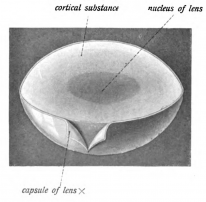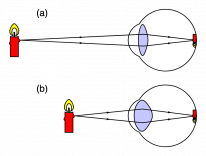The lens is a crystalline structure that plays an important role in accommodation. It is also prone to cataract disease, an extremely commonly encountered condition in ophthalmology.

Anatomy
The lens is a transparent crystalline structure which is suspended in between the vitreous and the iris by the zonular fibres of the ciliary body.
Dimensions and Structure

- Spheroid biconvex shape.
- Composed mainly of water (65%) and crystallins (34%).
- Lens is avascular and receives nutrients from the aqueous humour.
- The lens contains glutathione and ascorbic acid, which are antioxidants that stop cataractous formation.
- Adult lens (unaccommodated) is 6mm thick:
- 10mm of anterior curvature.
- 6mm of posterior curvature.
Lens Capsule
- The lens itself is tightly held inside a capsular bag made of type 4 collagen.
- The anterior part of the capsule (14 microns) is thicker than the posterior (4 microns).
- The peripheral part of the capsule is thicker than its centre.
- The anterior capsule is produced by the lens epithelium whilst the posterior capsule is formed from elongating lens fibres.
Lens Epithelium
- Lens epithelium is only found underneath the anterior capsule.
- A single layer.
- The epithelium at the centre is non-mitotic, whereas the epithelium at the periphery is mitotic.
Core Ultrastructure
- The lens itself has a cortex and a nucleus.
- The nucleus is in the centre and contains older lens fibres.
- The cortex contains recently formed fibres.
- Lens fibres are placed in a characteristic manner to form 2 sutures when looking at the lens head-on:
- Anterior 'Y' shaped suture.
- Posterior 'inverted Y' shaped suture.
Zonular Fibres
- Arise from the ciliary body and attach as sheets onto the lens capsule.
- Made of fibrillin.
- Zonular force keeps the capsular bag tense and the lens taut.
In their normal state, the zonular fibres are taut and hold the lens with tension. It is only with accommodation that these fibres relax and allow the lens to thicken from its tense arrangement.
Power
- Lens power is the extent to which it can refract light.
- Refractive index of 1.386 (around 1.4 centrally).
- Adult (unaccommodated) lens power is around 17D.
The lens counts for 1/3 of the total power of the eye (the other 2/3rds come from the cornea, around 43D). A common error is to think that the lens has the highest refractive power and that this is its primary role. It is more accurate to think about the role of the lens in the context of accommodation.
Accommodation
Ageing leads to a loss in the accommodative power of the lens, this is why adults need reading glasses at around the age of 50. The principles underlying this process are discussed here, alongside the process of accommodation.
Helmholtz Theory of Accommodation

- Ciliary muscles contract.
- Ciliary body becomes larger and moves closer to the lens → zonular fibres relax.
- Lens thickens (increases power to focus the light from the nearer image).
- Pupils constrict and converge.
- Choroid and Ora Serrata stretch forward.
It may seem odd that the contraction of the ciliary body would lead to a loss of tension in the zonular fibres. Remember that in the relaxed state, the ciliary body is further from the lens, therefore the zonular fibres are taut. During contraction of the ciliary body, it gets bigger and moves closer to the lens, providing slack for the zonular fibres. This decreases the tension on the capsular bag.
Accommodative Power
- With age, the lens hardens and the anterior capsule thickens - its power decreases because it loses the ability to change shape with accommodation:
- At birth → 16D
- 25 years → 8D
- 50 years → 2D
This loss of power leads to presbyopia (discussed further on the refraction page).

